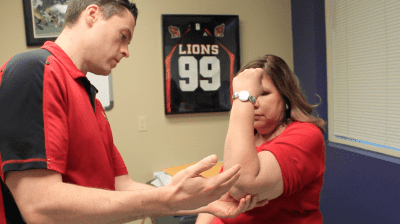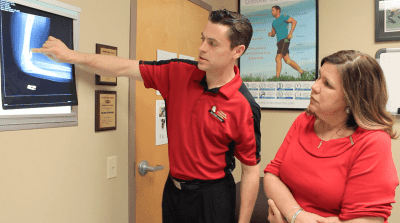Bilateral Elbow Replacement Saves Orlando Resident from Chronic Rheumatoid Arthritis Pain
- What is Total Elbow Replacement for Rheumatoid Arthritis?
- How Quick is Recovery from Total Elbow Replacement Surgery?
Hindered by chronic excruciating pain in her elbows, Miriam couldn’t accomplish even the simplest of household tasks, let alone lift her arms over her head. Tired of always being in pain or limited in what she could do in her day-to-day life, Miriam turned to Michael D. Riggenbach, M.D., a board certified orthopaedic surgeon at Orlando Orthopaedic Center specializing in hand and upper extremity surgery, peripheral nerve surgery, and microsurgery.
After attempting to treat her discomfort conservatively and discussing all available treatment options, Dr. Riggenbach and Miriam decided elbow replacement was the best way to provide long lasting pain relief from rheumatoid arthritis.
“I had an elbow replacement first performed here on my right elbow two years ago,” says Miriam. “Today, since the left elbow surgery performed eight months ago, I’m a lot stronger with both elbows. I’m extremely grateful for Dr. Riggenbach and his team.”
What is Total Elbow Replacement for Rheumatoid Arthritis?

After more traditional treatment methods had failed to resolve the problem, Miriam and Dr. Riggenbach decided that elbow replacement surgery was her best option.
“Miriam had rheumatoid arthritis, and it significantly impacted her elbows,” says Dr. Riggenbach. “We tried multiple attempts at injections and other conservative treatments to try and help her symptoms and improve her pain, but ultimately it required elbow replacements on both elbows.”
Roughly 3,000 total elbow replacements are done annually in America. The elbow acts as a hinge joint comprising three bones: the upper arm bone (humerus), the inner forearm bone (ulna), and the outer forearm bone (radius).
Elbow replacement surgery begins with Dr. Riggenbach making an incision behind the elbow and removing inflamed tissue and bone. An artificial hinge with metallic stems is then inserted into the hollow cavities of the bones. The wound is closed and the elbow splinted.
“We did one stage at a time,” says Dr. Riggenbach. “Miriam’s done very well with this and she’s returned to active daily living. Cleaning around the house is not a problem for her, and she’s pain-free in everyday life.”
Miriam says the biggest benefit to the surgery is that the pain she dealt with every day for so long is now just gone – a night and day difference.
“The excruciating pain that I was suffering with is no longer in my life. I couldn’t do simple things like wash dishes before. I couldn’t wash my hair. I couldn’t lift my arms above my head to shampoo and blow dry. I can do all those things today.”
How Quick is Recovery from Total Elbow Replacement Surgery?

“The second outpatient surgery was great,” she says. “I went home that evening, and you heal better when you’re at home. I slept better; I wasn’t tied up with any IVs; I didn’t get awakened early in the morning for medication,” she says. “I was on some very strong pain medication, but I only took those for one day.”
Rehabilitation and physical therapy play a pivotal role in regaining strength and normal function of the elbow following surgery. Gentle exercises are usually started once the wound has healed. Most patients are able to resume normal daily activities or lift smaller objects six to eight weeks post-operatively.
“As far as my elbows are concerned,” says Miriam with a smile, “I forget that there are even metal components in there.”
Following her successful bilateral elbow replacement procedures, Miriam is thankful for getting her life back and for being able to enjoy the little things in life again. “Combing my hair, doing dishes, simple things like that are small feats that for everybody else might not seem like a big deal, but they’re a big deal to me,” she says.
Having completed more than two years under Dr. Riggenbach’s care, Miriam will never forget the role he played in her healing journey.
“Dr. Riggenbach has always been very sincere with me, very compassionate, and he’s always told me the truth,” she says. “He’s just a wonderful doctor.”